Current cold calling statistics you should be aware of

In the realm of sales, the art of cold calling remains an enduring strategy. Though its effectiveness often evolves with the times.
That’s why staying informed about the current cold calling statistics is important to maximize its power.
This article will explore the numbers behind cold calling, its success rates, conversion rates, and strategies to refine the approach.
Cold calling statistics: Sales strategy by the numbers
Here are some essential cold calling statistics you need to be aware of:
“According to 42.1% businesses, their most effective sales tool is their phone.”
– Source: Sales Insights Lab
“Five or more call attempts can result in up to 70% conversion rates.”
– Source: Call Hippo
“Cold calls that last two times longer (5:50 minutes) are successful.”
– Source: Gong.io
“ The best time to initiate cold calls is between four and five in the afternoon.”
– Source: Call Hippo
“The optimal days for cold calling are Wednesdays and Thursdays.”
– Source: Gong.io
“When representatives monologue, cold calls become more successful.”
– Source: Gong.io
“Sixty-three% of sales workers claim cold calling is their worst task.”
– Source: LinkedIn
“82% of buyers engage with sellers who proactively cold calling.”
– Source: RAIN Group
Success rate of cold calling
The approach may have its skeptics, but cold calling statistics speak for themselves.
According to Cognism, the success rate of cold calling stands at an average of 2%. This figure underscores the challenging nature of this method, where persistence and precision are key.
Compared to other sales techniques, its success rate is a lot lower. However, as a form of outbound lead generation, cold calling is still an effective and viable sales strategy.
Cognism also discovered that it takes around eight attempts to reach a prospect. And once there’s a qualified lead, 20% will turn into a sale.
Cold calling: Does it still work?
Contrary to popular belief, cold calling still holds value in the sales landscape. Conversion rates are significant in determining its effectiveness.
Tech.co found that on average, 18% of cold calls become high-quality leads.

Sales professionals also often wonder about the optimal number of calls to make in a day.
Salestrail claims the sweet spot falls between six to eight calls per prospect. It adds that connecting and converting a lead takes an average of 18 attempts.
Balancing quantity with quality is key, ensuring each call is tailored, engaging, and backed by research.
Additionally, response rates provide a glimpse into the engagement levels generated by cold calls. Zippia found that well-crafted messages for cold calls can increase response rates between 8% and 12%.
It was discovered that 30 seconds is the ideal length for a call, and for every second beyond, chances of success decrease by 2%.
While other methods have emerged, cold calling holds its ground. It’s not a matter of whether it works but rather how it’s executed and integrated within a robust sales strategy.
Cold calling statistics among salespeople
The sentiment around cold calling is an intriguing juxtaposition.
Despite being considered the least favorite part of their roles by 63% of sales reps, Zippia’s findings reveal an interesting contradiction.
These professionals make an average of around 33 phone calls each day. This speaks to the paradoxical nature of cold calling — a task that may not be enjoyed but is recognized as an essential component of their daily routines.
Further insights from Revenue.io, sourced from CSO Insights, uncover a concerning trend; Around 42% of salespeople express feeling unprepared for their cold calls.
This observation pinpoints the critical need for ongoing training and skill development to do this strategy.
The numbers hint at the significant impact that focused training and preparation can have on improving the efficiency and outcomes of cold calling efforts.
Gong.io introduces a fascinating twist to the art of initiating a cold call.
Its data indicates that sales reps who open their calls with “How are you?” or “How have you been?” perform 6.6 times better during cold calls.
This alludes to the psychology behind these questions — catching buyers off guard with a non-standard opener. So, sales professionals manage to steer the conversation away from the automatic response of disinterest.
The approach creates an opportunity to engage the potential client more genuinely and unexpectedly, setting the stage for more productive interactions.
Cold calling statistics among buyers
On the other side, cold calling statistics from buyers’ perspectives offer valuable insights as well.
Data shared by Zippia highlights the impact of cold calling from the buyers’ standpoint. Remarkably, the statistics indicate that 82% of buyers accept sales meetings following a cold call.
This revelation challenges any preconceived notions of cold calls being an outdated or ineffective strategy.
Instead, it shows that well-executed cold calls have the potential to captivate the attention of potential clients and initiate productive conversations.
Zippia also offered additional validation for the efficacy of cold calls. It revealed that a substantial 69% of buyers had accepted one or more sales calls over the past year.
This debunks the notion that cold calls are met with resistance or avoidance. Rather, they highlight the willingness of potential clients to engage in dialogues when approached thoughtfully and professionally.
Although, the journey from a cold call to a successful sale is not always linear. Call Hippo’s insights reveal a significant aspect of this process; Over 35% of leads do not receive a follow-up after the initial contact.
From this, we can conclude there’s a need for persistence and consistency in nurturing leads. It emphasizes that while an initial cold call might spark interest, subsequent interactions are crucial for:
- Building rapport
- Addressing concerns
- Ultimately closing the deal
Moreover, Gong.io introduces a pivotal aspect that influences conversion rates. Data reveals that prospects are 10% more likely to convert if pricing is discussed during the first call.
This shows the importance of transparency and forthrightness in sales conversations.
Discussing pricing early not only shows a straightforward approach but also reflects a level of commitment and intent on the part of the prospect.

B2B cold calling statistics
ValueSelling Associates and Selling Power conducted research that sheds light on the psychology of B2B salespeople.
Its findings reveal that 48% of these professionals are apprehensive when making cold calls. This hesitancy might be rooted in the uncertainties of initial interactions and concerns about rejection.
The research also highlights another intriguing statistic; 53% of B2B sales reps tend to abandon the cold calling process prematurely. This emphasizes the importance of perseverance in the face of challenges.
Establishing meaningful connections and nurturing relationships demand dedication and patience. Those who persist beyond initial hurdles are more likely to discover hidden opportunities and develop authentic partnerships.
Despite these challenges, Revenue.io paints a compelling picture of the potential outcomes.
According to their research, B2B tech sales reps typically make an average of 35 calls daily, investing nearly an hour in conversations with potential customers.
This speaks to the proactive nature of B2B sales, where consistent effort builds rapport and trust over time. From a practical standpoint, the numbers emphasize the importance of time management and skillful engagement.
B2B sales professionals who allocate their calls effectively and engage in meaningful conversations have a higher chance of converting prospects into clients.
Cold calling statistics by metrics
Tracking and analyzing cold calling statistics for continuous improvement is essential to optimize your strategy.
Key monitoring metrics can include call duration, number of dials, and appointments set.
More findings from Zippa suggest that the average duration for successful cold calls is around 5:50 to 7:50 minutes. This stresses the need for engaging and concise conversations.
Additionally, 93% of the success of a cold call is dependent on the tone a rep uses. The win rate doubles if a salesperson shares their reason for the cold outreach.
A successful cold call discusses a prospect’s business problems. That’s why 66% say it’s important for sales reps to show how their product or service solves a buyer’s problems.
Cultivate your cold calling skills
Embarking on a cold calling journey requires more than just picking up the phone and reciting a script. It demands finesse, adaptability, and a strategic approach that can turn an initial conversation into a valuable connection.
Now that we know what this approach entails due to the provided cold calling statistics, we can learn useful tips to hone this skill:
- Create a concise and engaging pitch that hooks the prospect within seconds.
- Anticipate common objections and have well-prepared responses to address them smoothly.
- Pay close attention to the prospect’s needs and tailor your pitch accordingly.
- Treat rejections as opportunities to learn and improve rather than setbacks.
- Research prospects and tailor your pitch to their specific pain points.
- Leverage data analytics and CRM tools to enhance your understanding of prospects.
- Persevere through challenges and keep refining your skills over time.
- Start conversations with intriguing questions that catch prospects off guard.
- Maintain a natural tone and foster genuine conversations rather than scripted interactions.
- Stay updated with evolving trends, tactics, and insights to stay ahead in the cold calling game.







 Independent
Independent




